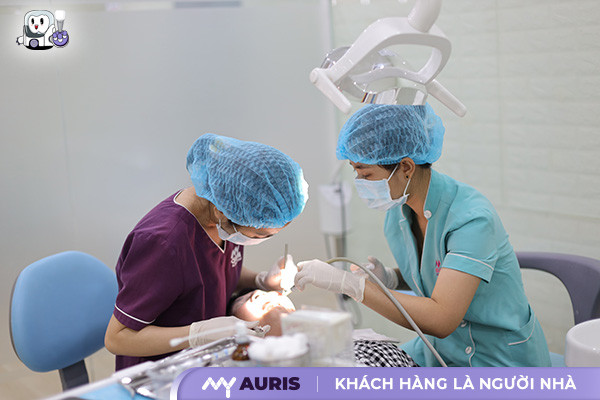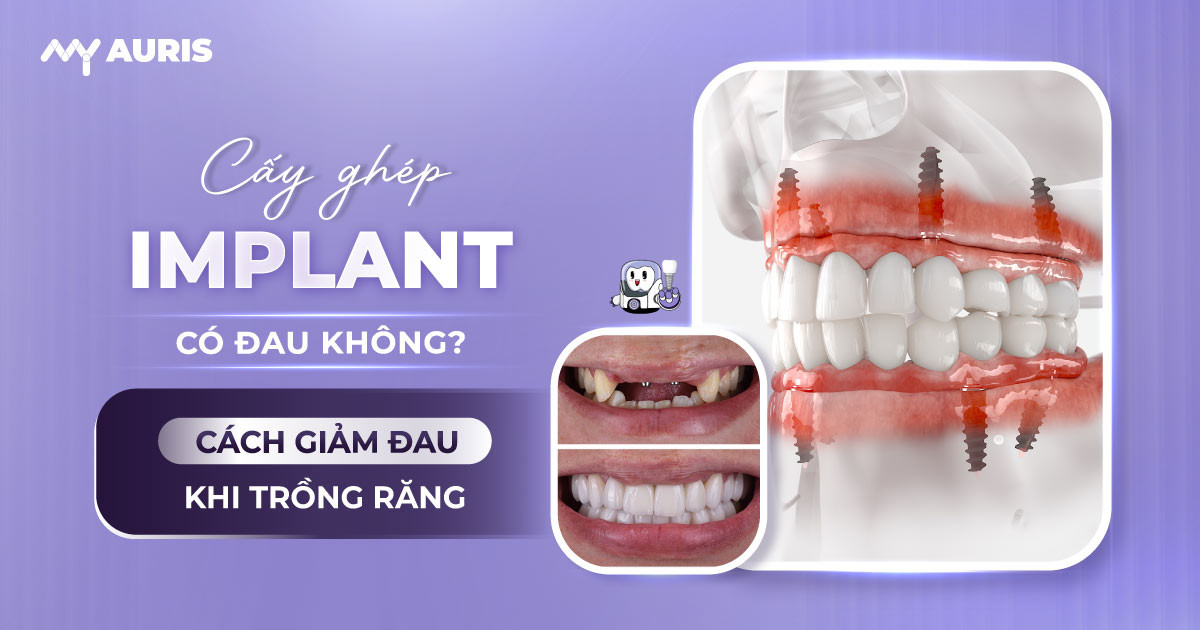Dental implant placement is a modern dental restoration method that helps restore missing teeth, providing high aesthetic results and improving chewing ability. However, many people are still concerned about whether dental implant placement is painful. This article from My Auris Dental Clinic will help answer this question!
Does Implant Placement Cause Pain?
When thinking about dental implant placement, many people easily imagine the pain of drilling or screwing into the jawbone. However, in reality, this procedure is much gentler than tooth extraction. Thanks to local anesthesia, patients remain fully conscious throughout the process without feeling pain. In some special cases, general anesthesia may also be used to ensure absolute comfort.
Normally, throughout the implant placement surgery, patients will not experience pain, especially when the gum tissue and jawbone are healthy. If still anxious, the doctor may prescribe additional painkillers or sedatives to provide psychological support for the patient.
The technique itself does not cause pain because the oral area is completely numb before surgery. After the implant, some people may feel mild post-operative pain, but the level is negligible, even less than the pain from a tooth extraction. However, if the implant is not placed correctly or infection occurs, the pain can be prolonged and more severe.
Currently, implant placement is a popular technique that not only restores chewing function but also provides a natural smile, long-lasting teeth, and the sensation of normal eating activities like real teeth. This is an optimal choice for those who want to regain confidence and sustainable quality of life.

Factors Affecting Pain Sensation During Implant Placement
There are many factors that influence this sensation, and understanding them will help you better prepare mentally and physically.
Dental Anesthesia Technique
Local anesthesia is a crucial step in the dental implant procedure. If anesthesia is performed correctly, the patient will not feel pain during the placement of the implant post into the jawbone. After the anesthetic wears off, a dull ache may appear, but it is usually mild to moderate and can be controlled with common painkillers. Prolonged pain often occurs if the anesthesia or surgical procedure is not optimized.
Missing Tooth Location and Jawbone Condition
The implant site significantly affects the level of pain. Implant placement in the lower jaw molars usually causes less pain due to better bone density and fewer nerves compared to the incisor region. Additionally, individuals with strong jawbones generally recover faster and experience less pain than those with bone loss or who required bone grafting beforehand.
Number of Implant Posts Required
The more implant posts are placed, the longer the procedure takes, and the level of post-operative pain tends to increase. In cases of full-arch oral rehabilitation or fixed prosthetic placement with multiple implants, patients need close monitoring during recovery to minimize implant complications and better manage pain.
Dentist’s Expertise and Implant Placement Procedure
The dentist’s expertise plays a decisive role in the level of pain. An experienced dentist will perform the dental implant procedure correctly and help minimize impact on gum tissue and alveolar bone. Additionally, modern dental implant systems combined with Cone Beam CT scans assist in precisely locating the ideal implant placement, making the procedure faster and less painful.
Type of Implant Post and Artificial Tooth Structure
Dental titanium posts are designed for good biocompatibility with the jawbone. However, if the patient is allergic to metal or an unsuitable post type is chosen, pain may last longer due to the body’s reaction. Opting for popular implant posts from reputable brands will help limit peri-implantitis or loss of gum sensation after surgery.
Overall Health and Patient Psychology
Individuals in good health without chronic conditions like diabetes or high blood pressure generally recover faster and experience less pain. The psychological fear of pain before dental implant placement is also a factor that increases post-operative discomfort. A stable mindset will help the recovery process after implantation proceed more smoothly.
Post-operative Care Directly Affects Pain Sensation
After direct placement into the jawbone, patients must follow post-operative care instructions. Poor hygiene can lead to infection causing prolonged pain. Eating properly, taking prescribed medication, avoiding impact to the implant site, and regular follow-up appointments are ways to reduce the risk of toothache and increase the implant’s permanent survival.
How to Effectively Reduce Pain During Dental Implant Placement?
Post-operative pain after dental implant placement is a common concern. However, by understanding the causes and knowing how to manage it correctly, most patients can effectively control the pain sensation. Here are practical guidelines to help you significantly reduce pain after dental implant surgery:

Use Painkillers Correctly (Dosage and Timing)
Immediately after surgery, your dentist will prescribe painkillers and anti-inflammatory drugs. You need to take them at the correct dosage and time, even if you don’t feel severe pain yet. Consistent use helps prevent pain from flaring up after the anesthetic wears off. Do not arbitrarily increase or skip doses as this can affect your liver, kidneys, and gum tissue recovery.
- If you experience significant pain within the first 48 hours, you may use non-steroidal anti-inflammatory drugs (NSAIDs) as directed by your doctor.
- Absolutely do not use strong painkillers like opioids without a prescription.

Apply Cold Compress Correctly During the First 24–48 Hours
Applying a cold compress to the outer cheek area at the implant site within the first 24 hours helps constrict blood vessels, reduce swelling, and limit radiating pain. Apply the compress for about 15–20 minutes each time, with 1-hour intervals.
- Use a specialized cold pack or ice wrapped in a thin cloth.
- Avoid applying ice directly to the skin as it can cause frostbite.

Eat Appropriately to Avoid Damage to the Implant Site
Diet directly affects the recovery process and pain sensation. You should: Eat soft, cool, easy-to-swallow foods for the first 3 days. Avoid chewing on the implant side for at least 7 days. Do not consume spicy, hard, or hot foods as they will irritate the gum tissue and jawbone area where the implant is integrating.
Maintain Careful Oral Hygiene Without Strong Impact
Oral hygiene must be maintained after every meal to prevent bacterial invasion. However: do not use toothpicks or dental floss near the newly implanted site. Use an ultra-soft toothbrush and alcohol-free mouthwash. After 3–5 days, a gentle water flosser can be used for more thorough cleaning.
Follow-up Appointments on Schedule for Timely Check-ups and Treatment
After dental implant placement, you need to return to the dental clinic for scheduled follow-up appointments. The dentist will examine the implant post, gum tissue, and the state of bone integration. If there are unusual pain symptoms such as sharp pain, swelling with pus, or loss of gum sensation, these could be signs of complications like peri-implantitis, requiring early treatment.
Maintain a Relaxed Mindset, Avoid Prolonged Anxiety
Feelings of anxiety and stress can make you perceive pain more intensely. A stable mindset is a crucial factor in overcoming the post-operative period. You can listen to soothing music, meditate, or simply get more rest during the first few days.
How Long Does Pain Last After Dental Implant Placement?
Typically, pain after implant placement lasts approximately 3 to 7 days. After 2 weeks, most patients have fully recovered soft tissue and no longer experience discomfort. If the dental implant procedure is performed correctly, with effective local anesthesia, and the patient adheres to post-operative care, healing will occur quickly and safely.
Initial Stage: 24 to 72 Hours After Implant Placement
During the first 24 hours, the dentist usually prescribes painkillers, combined with cold compresses on the outer cheek to reduce swelling. This stage is crucial; it requires limiting strenuous activity, eating soft foods, and avoiding any impact on the implant site.
By the second or third day, the pain sensation will gradually decrease. Many patients describe the feeling as similar to after a tooth extraction or a deep filling. For individuals with good physical constitution and rapid implant-to-bone integration, discomfort subsides significantly after just 3 days.
Recovery Stage: From Day 4 to Day 14
From day 4 onwards, with proper care, the pain sensation almost disappears. At this point, the gum tissue is gradually stabilizing around the dental titanium post, and the process of biological integration with the jawbone begins.
This stage is also when the dentist conducts a follow-up examination, checking the healing progress of the gum tissue and evaluating the implant post integration. If no implant complications occur, the patient can begin to return to nearly normal activities.
Complete Stabilization Stage: From Week 3 to Month 3
From the third week onwards, the implant site almost no longer experiences toothache. The implant post is relatively stable in the alveolar bone, and the patient begins the stage of fixed prosthetic restoration.
Within approximately 6 to 12 weeks, most implant posts will complete the osseointegration process with the jawbone. This period can be shortened if the jawbone is healthy, or extended if bone grafting is required, or if the missing tooth area is a high-stress zone like the lower molars.
Should You Worry About Pain During Dental Implant Placement?
In reality, most patients find the pain during implant placement not as severe as imagined. Thanks to local anesthesia, patients feel no pain at all during the procedure. Some dental clinics even combine advanced anesthetic techniques to better control sensation, even for sensitive individuals.
Anxiety is a natural reaction, but you shouldn’t let the fear of pain prevent you from restoring chewing function and oral aesthetics. Modern dental implant systems are precisely designed, capable of biological integration with bone and long-term stability without affecting adjacent teeth.
If you’ve had wisdom teeth extracted, undergone dental crowning, or even braces, dental implant placement will not cause more pain. Most importantly, choose an experienced implant dentist and a reputable facility to ensure that this highly precise technique is performed correctly.
With a clear treatment plan, accurate assessment of gum tissue, alveolar bone, and missing tooth location, combined with precise dental anesthesia, you can be completely confident in undergoing the direct placement into the jawbone gently.





